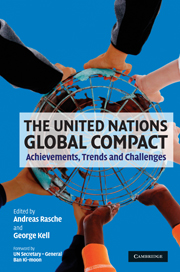Book contents
- Frontmatter
- Contents
- List of figures
- List of tables
- List of boxes
- List of abbreviations
- List of contributors
- Acknowledgements
- Foreword
- Why This Book Matters!
- The Ten Principles of the United Nations Global Compact
- 1 Introduction: the United Nations Global Compact – retrospect and prospect
- Part I Achievements, trends and challenges: reflections on the Principles
- Part II Participants and engagement mechanisms
- Part III Governance and Communication on Progress
- Part IV Local Networks: the emerging global–local link
- 18 Building the United Nations Global Compact Local Network model: history and highlights
- 19 The United Nations Global Compact as a Network of Networks
- 20 Running a Global Compact Local Network: insights from the experience in Germany
- 21 Building corporate citizenship through the United Nations Global Compact: contributions and lessons learned from the Argentinean Local Network
- 22 Concluding remarks: from alleviating the negative impacts of globalization to transforming markets
- Glossary
- Bibliography
- Index
20 - Running a Global Compact Local Network: insights from the experience in Germany
Published online by Cambridge University Press: 05 February 2012
- Frontmatter
- Contents
- List of figures
- List of tables
- List of boxes
- List of abbreviations
- List of contributors
- Acknowledgements
- Foreword
- Why This Book Matters!
- The Ten Principles of the United Nations Global Compact
- 1 Introduction: the United Nations Global Compact – retrospect and prospect
- Part I Achievements, trends and challenges: reflections on the Principles
- Part II Participants and engagement mechanisms
- Part III Governance and Communication on Progress
- Part IV Local Networks: the emerging global–local link
- 18 Building the United Nations Global Compact Local Network model: history and highlights
- 19 The United Nations Global Compact as a Network of Networks
- 20 Running a Global Compact Local Network: insights from the experience in Germany
- 21 Building corporate citizenship through the United Nations Global Compact: contributions and lessons learned from the Argentinean Local Network
- 22 Concluding remarks: from alleviating the negative impacts of globalization to transforming markets
- Glossary
- Bibliography
- Index
Summary
Introduction
Some eighty Global Compact Networks are on the ground locally, usually organized as national Networks. Spread across regions and entire continents, the various Global Compact Networks offer each other support, exchange and a link between the central Global Compact Office in New York, at UN Headquarters, and the individual company committed to the Global Compact's ten Principles.
When Kofi Annan envisioned it, the Global Compact started as an initiative without long-term plans concerning its operational structure. As it gained momentum, it became clear that the Global Compact Office in New York could hardly cater to all the different participants worldwide. Companies were joined by hybrid and civil society organizations in their effort to promote the ten Principles; characteristics differed starkly between the different business participants. Locality, sector, size and ownership structure create a variety of challenges; at times the only real connecting component was the commitment to the Global Compact itself. Thus, local support structures started to develop. Some were initiated by the United Nations itself, some grew from self-organized groups of signatories to the Global Compact, and others joined existing initiatives in the field of corporate responsibility. Over the last five years, these Local Networks started communicating and comparing their respective organizational structure and related problems, their output and assumed impact. With the Annual Local Networks Forum (ALNF) bringing together representatives from networks around the world – so-called Focal Points – a platform was created to streamline and coordinate these new structures and ensure their connection to other Global Compact entities.
- Type
- Chapter
- Information
- The United Nations Global CompactAchievements, Trends and Challenges, pp. 355 - 369Publisher: Cambridge University PressPrint publication year: 2010
- 3
- Cited by

